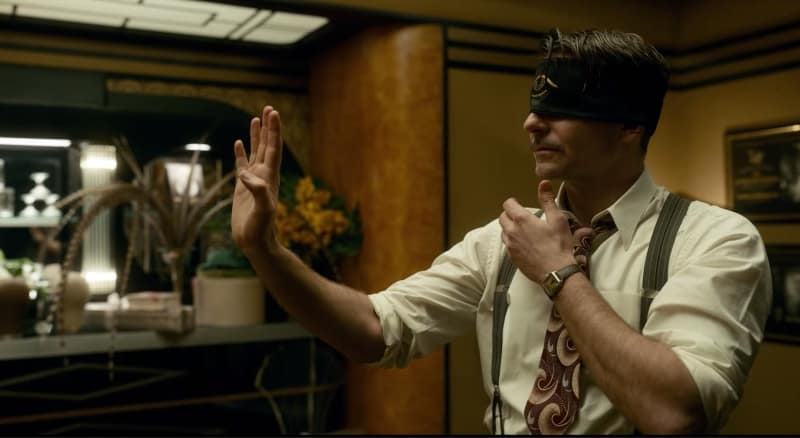Guillermo del Toro’s ‘Nightmare Alley’ Has Atmosphere to Spare
Bradley Cooper steals hearts, fortunes, and the film itself.

Remakes get a bad rap, often from the moment they’re announced, but there’s more than enough room at the multiplex for reimagined visions of past films. Ideally, a new take will strive to improve upon the original or at least add something to the experience, but sometimes the best a filmmaker can do is match the earlier endeavor while adding only updated bells and whistles. 1947’s Nightmare Alley is an impactful noir that hits viewers with a morally profound gut punch, and Guillermo del Toro‘s new film mostly manages the same — even if it does take forty minutes longer to do so. Nightmare Alley doesn’t improve upon the earlier film, but it still delivers the twisted beauty and emotionally corrupt drama you’re expecting.
We first meet Stanton Carlisle (Bradley Cooper) as he buries a body beneath a small shack’s floorboards and then sets the house ablaze. He makes his way to a traveling carnival, and after assessing his situation he convinces the man in charge (Willem Dafoe) to give him a job. It’s a murky world of greasy food, simple rides, and acts that waver between the cheap and the unnerving — mentalists trick the audience, while the chicken-biting “geek” disturbs them — and Stanton sees it as temporary shelter from the outside world.
His eyes are always on the future, though, and when he sees an opportunity he snatches it. Soon, he and the carnival’s most innocent member, Molly Cahill (Rooney Mara), leave the show and turn a carnie act into high class entertainment. The pair mesmerize high society with their mentalism shtick, but Stanton’s ambitions — his flat out greed and ego — leave him unsatiated until he meets Dr. Lilith Ritter (Cate Blanchett) and sees the possibility of even bigger scores. Were he an actual psychic, of course, he’d see that what goes up must inevitably come down.
Nightmare Alley is a big, sprawling character study absolutely oozing with atmosphere. Those characters and the story they’re immersed in may not need the excessive running time — two and a half hours to tell the same story the earlier film told arguably better at an hour fifty — but del Toro’s talent for finding beauty in the darkness ensures it’s never dull. Instead, it feels almost like a carnival ride itself, one that takes you on rails into a dimly lit tunnel illuminated by burning souls and pyres built by the morally bankrupt. The evils that men do have rarely been this lushly presented.
Stanton’s rise and fall are the focus here, and Cooper does terrifically amorphous work shifting between charming magnetism and dead-eyed sleaze. He’s not a man we’re meant to pity, necessarily, as his choices are continually made with intent and awareness, but Cooper’s performance almost convinces us that Stanton has no real choice at all. This is who he is, and that sociopathy is as intriguing as it is terrifying. By the time the final frame lands, Stanton’s revealing self-awareness hits hard.
The supporting players all do good work in Nightmare Alley even if they do feel typecast in some ways. Blanchett as a smart, steely eyed seductress? Mara as a young woman adrift in bad man’s world? Dafoe as a straight-shooter who knows the world he’s a part of? They’re all familiar enough roles, but the talents bring small moments of nuance and light all the same. Toni Collette and David Strathairn play a carnie couple, the mentalists who fall prey to Stanton’s devious ambitions, Ron Perlman and Holt McCallany play tough guys, and Richard Jenkins is a mean bastard hidden behind glasses and guilt. They’re ultimately all window dressing in support of Cooper and his character’s descent, but it’s hard to argue with this kind of talent no matter their purpose.
Instead, it’s the production design and cinematography that keep apace with Cooper and catch the eye at every turn. Tamara Deverell crafts a world that feels both drenched in 1940s style and removed from time itself. From the sweaty world of the carnies to the lush environs of high society, the film’s atmosphere envelopes viewers with an oppressive beauty captured through the lens of Dan Laustsen‘s camera. Nightmare Alley is a gorgeous descent into wickedness.
As mentioned above, though, Nightmare Alley is also longer than it needs to be. The script by del Toro and Kim Morgan feels compelled to add more to Stanton’s character than perhaps is necessary, and while the additional backstory doesn’t hurt the film in any real sense it’s unable to add more weight to the film’s final hit. It feels as if they wanted to imbue the man with an unneeded mystery when him being a mildly nuanced and soulless opportunist is more than enough. Again, the added minutes don’t drag, but they certainly don’t move things forward either.
It’s worth noting that this is actually del Toro’s most grounded film, a genre tale to be sure, but one that lives and breathes in the real world. There are no supernatural elements, creatures, or sci-fi creations to be found, and the result is perhaps his darkest film yet. Few things are more frightening than a lack of empathy, and Stanton is a man who would sell anyone out if it meant a profit and another rung on the social ladder.He cares for no one but himself, and that human darkness is as pitch black as it comes.
Nightmare Alley is a beautifully crafted ride that never feels as cheap as the grungy carnivals it’s touching upon, and instead even the seediest corners are given dimension and life. Villains walk among us, whether in rags or exquisitely designed threads, and the best we can hope for is that they’ll one day find themselves in their own dead end.
